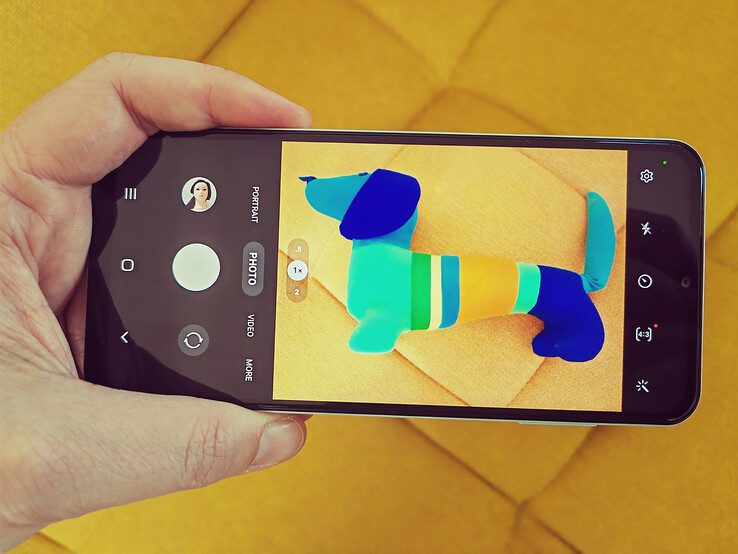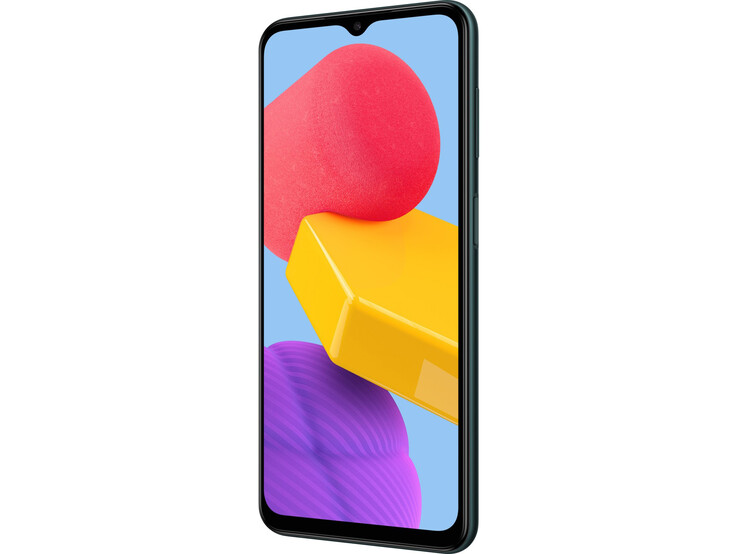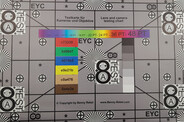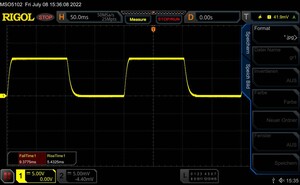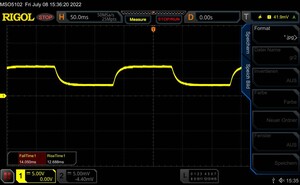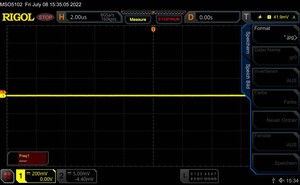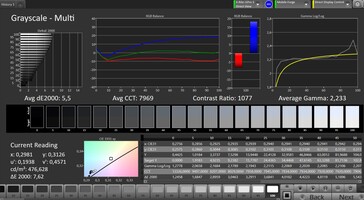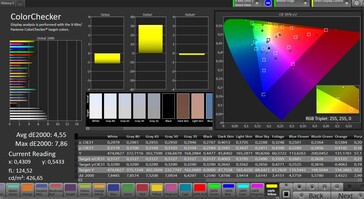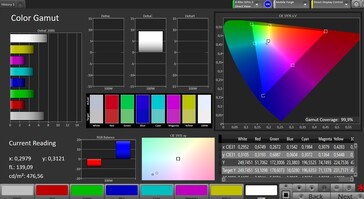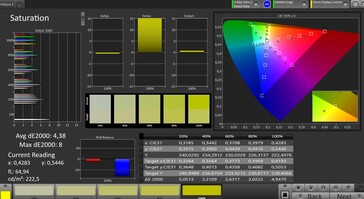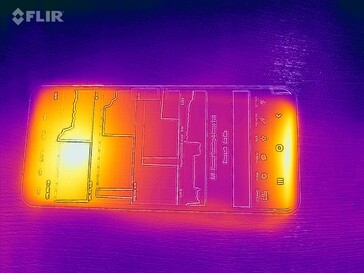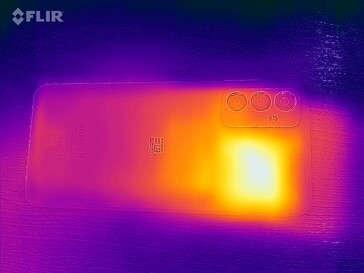Smartphone review: Samsung Galaxy M13 – budget phone with Wi-Fi 5 and Full HD
Comparison with possible competitors
Rating | Date | Model | Weight | Storage | Size | Resolution | Best price |
|---|---|---|---|---|---|---|---|
| 75.8 % v7 (old) | 07 / 2022 | Samsung Galaxy M13 Exynos 850, Mali-G52 MP1 | 192 g | 64 GB eMMC Flash | 6.60" | 2408x1080 | |
| 80 % v7 (old) | 05 / 2022 | Xiaomi Redmi Note 11 SD 680, Adreno 610 | 179 g | 64 GB UFS 2.2 Flash | 6.43" | 2400x1080 | |
| 76.5 % v7 (old) | 05 / 2022 | Samsung Galaxy A13 4G Exynos 850, Mali-G52 MP1 | 195 g | 64 GB eMMC Flash | 6.60" | 2408x1080 | |
| 78.9 % v7 (old) | 01 / 2022 | Motorola Moto G31 Helio G85, Mali-G52 MP2 | 181 g | 64 GB eMMC Flash | 6.40" | 2400x1080 | |
| 75.7 % v7 (old) | 06 / 2021 | Samsung Galaxy M12 Exynos 850, Mali-G52 MP1 | 214 g | 64 GB eMMC Flash | 6.50" | 1600x720 |
Case and features – virtual sensors
Although the M13 predecessor, the Samsung Galaxy M12, was a decent budget smartphone, it offered too little performance and had a low-resolution screen. Its main camera also produced videos that didn't impress us. The Samsung Galaxy M13 has addressed some of these points of criticism and now offers a Full HD screen and a partially new camera setup.
The Galaxy M13 still shares some design elements with its predecessor. For example, the rear still has a subtle wavy pattern but drops the vertical lines. This time around, Samsung is offering the phone in "Deep Green", "Light Blue" and "Orange Copper".
The plastic housing is typical for phones in this price range, but it is very well-built and features soft transitions between materials. Pressure can hardly get through to the screen.
At around 190 Euros ($192), the Galaxy M13 with 64 GB of storage is 10 Euros (~$10) cheaper than the previous model. You can also find a 128 GB variant on the Internet, which costs around 20 Euros (~$20) more. Both models come with 4 GB of RAM.
Like its predecessor, the phone supports NFC – which is still not always a given for a device under 200 Euros (~$202). NFC is required, for example, if you want to use Google Pay or other contactless applications.
One unique feature of the Galaxy M13 is its virtual light and proximity sensor. Instead of having a separate sensor to control screen brightness or turn off the display during a call, the phone uses the front camera and a software solution to detect the corresponding situations. The results are mediocre when it comes to detecting lighting conditions, as the sensor reacts slowly or not at all to very strong ambient light. On the other hand, the proximity sensing works fairly reliably during a call.
The microSD reader remains usable even with two SIM cards in the device and is average for the price range in terms of speed.
| SD Card Reader - average JPG Copy Test (av. of 3 runs) | |
| Samsung Galaxy A13 4G (Angelbird V60) | |
| Average of class Smartphone (5.72 - 58.9, n=67, last 2 years) | |
| Samsung Galaxy M13 (Angelbird V60) | |
| Xiaomi Redmi Note 11 (Angelbird AV Pro V60) | |
| Motorola Moto G31 (Angelbird V60) | |
Cross Platform Disk Test (CPDT)
Connectivity, software and usability – Wi-Fi 5 at long last
Compared with the Galaxy M12, the new phone has been upgraded to Wi-Fi 5, which is overdue even in this price category. During our tests using the reference router Asus ROG AXE11000, we managed to get stable speeds of around 325 Mbits/s.
In terms of mobile network coverage, the phone supports up to LTE but not too many frequencies. This means that you can't be sure whether you will be able to use mobile Internet while abroad. We tested the smartphone's reception quality at random and found that it doesn't quite measure up to more expensive phones. Occasionally, the Galaxy M13's signal strength was only around half that of other phones at the same location.
On the Galaxy M13, Samsung has installed Android 12 with their own One UI overlay, which features some design changes that facilitate one-handed use of the phone. Samsung uses its own apps in many areas, but has at least stopped preinstalling Google apps (apart from the news app and gallery) with similar functionality on top of its apps. Although the phone comes with preinstalled advertising apps, there are only very few of them.
The touchscreen is highly precise to use. The fingerprint sensor is built into the standby button on the right side of the phone. It reacts properly to a finger that has been registered and unlocks the phone in a flash. You can also use facial recognition to unlock the phone. This feature works without any issues; however, it is a purely software-based solution and is therefore not as secure.
| Networking | |
| iperf3 transmit AX12 | |
| Motorola Moto G31 | |
| iperf3 receive AX12 | |
| Motorola Moto G31 | |
| iperf3 transmit AXE11000 | |
| Samsung Galaxy A13 4G | |
| Samsung Galaxy M13 | |
| Xiaomi Redmi Note 11 | |
| iperf3 receive AXE11000 | |
| Samsung Galaxy A13 4G | |
| Samsung Galaxy M13 | |
| Xiaomi Redmi Note 11 | |
Cameras – muddy wide-angle images
Samsung has removed the depth camera for taking portraits, which was of dubious utility. Instead, the Galaxy M13 now features a 50MP main camera, a 5MP wide-angle camera and a 2MP macro camera.
The main camera uses the Samsung Isocell JN1 sensor. It has fairly small pixels but bins four of them into a larger pixel to take 12.5MP images with decent light sensitivity. The sharpness and detail of the photos are average at best. The white flowers on the plant are clearly overexposed. Larger areas appear somewhat grainy and the candle flame is overexposed in the low-light and high-contrast situation. Although no details can be seen in very dark areas, the camera is able to reproduce details quite well.
The phone can record videos at up to 1080p and 30 fps. However, only digital zoom is available when taking videos. The sluggish autofocus continues to be the biggest problem of the phone's video recording capabilities, which are otherwise decent for phones in this price range.
The 5MP wide-angle lens produces acceptable photos, with the distortion at the edges being quite well corrected. A noticeably soft-looking band can be seen at the picture's left edge, and the trees on the right are likewise very blurry.
The 8MP front camera takes good pictures under normal lighting conditions. In darker places, however, it struggles to reproduce details.
Image comparison
Choose a scene and navigate within the first image. One click changes the position on touchscreens. One click on the zoomed-in image opens the original in a new window. The first image shows the scaled photograph of the test device.
Main camera FlowerMain camera Environment Main camera Low LightWide-angle camera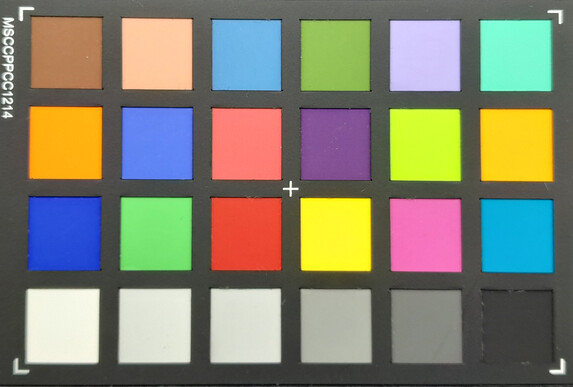
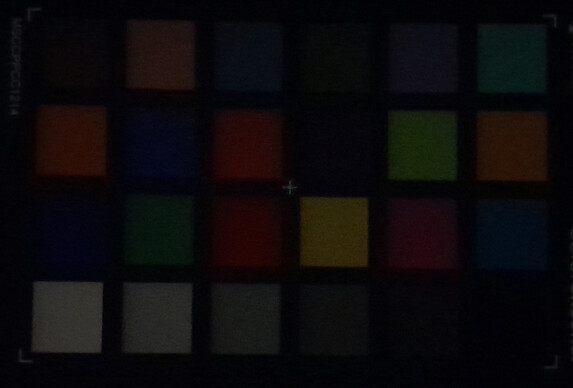
Display – now in Full HD but with dull colors
There is finally an inexpensive phone in the Galaxy M series that features a Full HD screen. Samsung was at risk of being left in the dust by the competition in this department. However, manufacturers like Xiaomi and Motorola are meanwhile already equipping phones in this price category with OLED displays, while Samsung is still holding on to PLS panels.
As a result, the Galaxy M13's display is somewhat dull and has less contrast than some of its competitors. Colour reproduction is also significantly less accurate, as shown by the tests we performed using a spectrophotometer and the CalMAN software. The screen also has a distinct blue tinge when displaying shades of grey.
| |||||||||||||||||||||||||
Brightness Distribution: 85 %
Center on Battery: 481 cd/m²
Contrast: 1119:1 (Black: 0.43 cd/m²)
ΔE ColorChecker Calman: 4.55 | ∀{0.5-29.43 Ø4.78}
ΔE Greyscale Calman: 5.5 | ∀{0.09-98 Ø5}
99.9% sRGB (Calman 2D)
Gamma: 2.233
CCT: 7969 K
| Samsung Galaxy M13 PLS, 2408x1080, 6.6" | Xiaomi Redmi Note 11 OLED, 2400x1080, 6.4" | Samsung Galaxy A13 4G PLS, 2408x1080, 6.6" | Motorola Moto G31 OLED, 2400x1080, 6.4" | |
|---|---|---|---|---|
| Response Times | 92% | -59% | 68% | |
| Response Time Grey 50% / Grey 80% * (ms) | 27 ? | 1.135 ? 96% | 47 ? -74% | 6 ? 78% |
| Response Time Black / White * (ms) | 14 ? | 1.635 ? 88% | 20 ? -43% | 6 ? 57% |
| PWM Frequency (Hz) | 171.4 | 223.2 | ||
| Screen | 57% | 5% | 25% | |
| Brightness middle (cd/m²) | 481 | 702 46% | 553 15% | 423 -12% |
| Brightness (cd/m²) | 444 | 701 58% | 506 14% | 425 -4% |
| Brightness Distribution (%) | 85 | 98 15% | 87 2% | 94 11% |
| Black Level * (cd/m²) | 0.43 | 0.44 -2% | ||
| Contrast (:1) | 1119 | 1257 12% | ||
| Colorchecker dE 2000 * | 4.55 | 1 78% | 4.64 -2% | 1.58 65% |
| Colorchecker dE 2000 max. * | 7.86 | 2.3 71% | 7.86 -0% | 4.68 40% |
| Greyscale dE 2000 * | 5.5 | 1.4 75% | 5.6 -2% | 2.7 51% |
| Gamma | 2.233 99% | 2.2 100% | 2.18 101% | 2.219 99% |
| CCT | 7969 82% | 6520 100% | 8002 81% | 6674 97% |
| Total Average (Program / Settings) | 75% /
66% | -27% /
-8% | 47% /
36% |
* ... smaller is better
Display Response Times
| ↔ Response Time Black to White | ||
|---|---|---|
| 14 ms ... rise ↗ and fall ↘ combined | ↗ 9 ms rise | |
| ↘ 5 ms fall | ||
| The screen shows good response rates in our tests, but may be too slow for competitive gamers. In comparison, all tested devices range from 0.1 (minimum) to 240 (maximum) ms. » 33 % of all devices are better. This means that the measured response time is better than the average of all tested devices (20.2 ms). | ||
| ↔ Response Time 50% Grey to 80% Grey | ||
| 27 ms ... rise ↗ and fall ↘ combined | ↗ 14 ms rise | |
| ↘ 13 ms fall | ||
| The screen shows relatively slow response rates in our tests and may be too slow for gamers. In comparison, all tested devices range from 0.165 (minimum) to 636 (maximum) ms. » 35 % of all devices are better. This means that the measured response time is better than the average of all tested devices (31.6 ms). | ||
Screen Flickering / PWM (Pulse-Width Modulation)
| Screen flickering / PWM not detected | |||
In comparison: 53 % of all tested devices do not use PWM to dim the display. If PWM was detected, an average of 8101 (minimum: 5 - maximum: 343500) Hz was measured. | |||
Performance, emissions and battery life – lacking in performance
We thought the Samsung Exynos 850 was adequate in the Galaxy M12 for its price range. One year later, however, the same SoC in the Galaxy M13 is clearly too slow when compared with the Snapdragon 680 in the Xiaomi Redmi Note 11.
With performance differentials reaching 40, 50 or even 70 per cent in our benchmarks, it is clear how far the phone is trailing behind in terms of performance. This is noticeable, for example, when you restart the phone: it takes a long time for the phone to become actually usable again. In day-to-day use, we also don't recommend running overly demanding apps on the Galaxy M13. Otherwise, the phone will start to visibly stutter. This is in part due to the very slow eMMC storage.
Under load, the smartphone only becomes slightly warm in certain parts and therefore remains comfortable to use.
The speaker sounds quite thin and is unable to cope with more powerful sections of a music track. While it at least doesn't buzz at full volume, the speaker is also not very loud when turned all the way up.
It is more enjoyable to use a pair of headphones or external speakers when listening to music on the phone. They can be connected via the 3.5 mm audio jack or Bluetooth. The phone supports a decent selection of Bluetooth codecs (including aptX). However, none of them are capable of HD audio, meaning sound quality is rather average.
Samsung didn't include any charger with this budget phone. With a maximum charging speed of 15 watts, the phone will take up to 2 hours to fully charge its large 5,000 mAh battery. On a full charge, you will be able to browse the Internet for almost 15 hours before the battery is depleted. Consequently, depending on usage, the phone should be able to last you two days without having to be charged.
| GFXBench | |
| on screen Aztec Ruins Normal Tier Onscreen (sort by value) | |
| Samsung Galaxy M13 | |
| Xiaomi Redmi Note 11 | |
| Samsung Galaxy A13 4G | |
| Motorola Moto G31 | |
| Average Samsung Exynos 850 (5.3 - 12, n=7) | |
| Average of class Smartphone (6.2 - 166, n=209, last 2 years) | |
| 1920x1080 Aztec Ruins Normal Tier Offscreen (sort by value) | |
| Samsung Galaxy M13 | |
| Xiaomi Redmi Note 11 | |
| Samsung Galaxy A13 4G | |
| Motorola Moto G31 | |
| Average Samsung Exynos 850 (6.1 - 6.2, n=7) | |
| Average of class Smartphone (3.4 - 367, n=209, last 2 years) | |
| on screen Aztec Ruins High Tier Onscreen (sort by value) | |
| Samsung Galaxy M13 | |
| Xiaomi Redmi Note 11 | |
| Samsung Galaxy A13 4G | |
| Motorola Moto G31 | |
| Average Samsung Exynos 850 (3.3 - 7.4, n=7) | |
| Average of class Smartphone (0.85 - 144, n=210, last 2 years) | |
| 2560x1440 Aztec Ruins High Tier Offscreen (sort by value) | |
| Samsung Galaxy M13 | |
| Xiaomi Redmi Note 11 | |
| Samsung Galaxy A13 4G | |
| Motorola Moto G31 | |
| Average Samsung Exynos 850 (2.2 - 2.2, n=7) | |
| Average of class Smartphone (1.2 - 146, n=209, last 2 years) | |
| Samsung Galaxy M13 | Xiaomi Redmi Note 11 | Samsung Galaxy A13 4G | Motorola Moto G31 | Average 64 GB eMMC Flash | Average of class Smartphone | |
|---|---|---|---|---|---|---|
| AndroBench 3-5 | 288% | 77% | 98% | 13% | 804% | |
| Sequential Read 256KB (MB/s) | 264.5 | 895.34 239% | 308.5 17% | 309.8 17% | 277 ? 5% | 2228 ? 742% |
| Sequential Write 256KB (MB/s) | 193.5 | 519.23 168% | 236.8 22% | 221.5 14% | 178.4 ? -8% | 1852 ? 857% |
| Random Read 4KB (MB/s) | 42.5 | 172.95 307% | 104.4 146% | 84 98% | 60.7 ? 43% | 296 ? 596% |
| Random Write 4KB (MB/s) | 30.3 | 163.29 439% | 67.3 122% | 109.8 262% | 33.8 ? 12% | 339 ? 1019% |
Temperature
(+) The maximum temperature on the upper side is 38.2 °C / 101 F, compared to the average of 35.2 °C / 95 F, ranging from 21.9 to 247 °C for the class Smartphone.
(±) The bottom heats up to a maximum of 41.1 °C / 106 F, compared to the average of 34 °C / 93 F
(+) In idle usage, the average temperature for the upper side is 27.5 °C / 82 F, compared to the device average of 32.9 °C / 91 F.
Speaker
Samsung Galaxy M13 audio analysis
(±) | speaker loudness is average but good (81.4 dB)
Bass 100 - 315 Hz
(-) | nearly no bass - on average 26.3% lower than median
(±) | linearity of bass is average (12% delta to prev. frequency)
Mids 400 - 2000 Hz
(±) | higher mids - on average 6.1% higher than median
(+) | mids are linear (6% delta to prev. frequency)
Highs 2 - 16 kHz
(±) | higher highs - on average 7.2% higher than median
(±) | linearity of highs is average (7.8% delta to prev. frequency)
Overall 100 - 16.000 Hz
(±) | linearity of overall sound is average (25.6% difference to median)
Compared to same class
» 63% of all tested devices in this class were better, 7% similar, 30% worse
» The best had a delta of 11%, average was 35%, worst was 134%
Compared to all devices tested
» 78% of all tested devices were better, 5% similar, 17% worse
» The best had a delta of 4%, average was 24%, worst was 134%
Motorola Moto G31 audio analysis
(±) | speaker loudness is average but good (80.7 dB)
Bass 100 - 315 Hz
(-) | nearly no bass - on average 25.3% lower than median
(±) | linearity of bass is average (9.8% delta to prev. frequency)
Mids 400 - 2000 Hz
(+) | balanced mids - only 4.4% away from median
(±) | linearity of mids is average (7% delta to prev. frequency)
Highs 2 - 16 kHz
(±) | higher highs - on average 5.1% higher than median
(+) | highs are linear (6.5% delta to prev. frequency)
Overall 100 - 16.000 Hz
(±) | linearity of overall sound is average (20.5% difference to median)
Compared to same class
» 35% of all tested devices in this class were better, 9% similar, 56% worse
» The best had a delta of 11%, average was 35%, worst was 134%
Compared to all devices tested
» 53% of all tested devices were better, 8% similar, 39% worse
» The best had a delta of 4%, average was 24%, worst was 134%
Battery life
| Battery Runtime - WiFi Websurfing | |
| Average of class Smartphone (12.1 - 54.1, n=209, last 2 years) | |
| Motorola Moto G31 | |
| Samsung Galaxy M13 | |
| Samsung Galaxy A13 4G | |
| Xiaomi Redmi Note 11 | |
Pros
Cons
Verdict – noticeably improved, but lacking in certain areas
The Samsung Galaxy M13 is slightly less expensive than its predecessor and yet offers a few updates: in particular, the high-resolution screen is a welcomed change, even if it is still a somewhat dull-looking PLS panel.
The camera's autofocus still can't handle videos well, and we don't exactly recommend examining photos from the wide-angle camera too closely. Having said that, the main camera's image quality is absolutely acceptable for a phone in this price range.
Samsung really needs to give the next budget Galaxy M phone more performance because the Galaxy M13 has fallen significantly behind similarly priced devices from other manufacturers in this regard.
The Samsung Galaxy M13 offers a well-built chassis, NFC support and fast Wi-Fi. However, there are still better alternatives available in terms of performance and screen.
If you prefer a bright and vibrant OLED screen, then the Xiaomi Redmi Note 11 is probably the better choice for you. If a high-resolution screen is not as important to you, then you might also want to consider the predecessor Galaxy M12, which can now be had for much cheaper.
Price and availability
The Samsung Galaxy M13 is available from Amazon UK or the manufacturer's online shop for $172. The 128 GB version is currently not yet available in the UK.
Samsung Galaxy M13
- 07/12/2022 v7 (old)
Florian Schmitt




